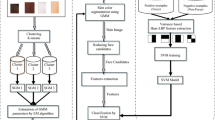Abstract
Recently, in the context of appearance-based face detection, it has been shown by Mita et al. that weak classifiers based on co-occurring, or multiple, Haar-like features provide better speed-accuracy trade-off than the widely used Viola and Jones’s weak classifiers, which use only a single Haar-like feature. In this paper, we extend Mita et al.’s work by proposing Gaussian weak classifiers that fuse information obtained from the co-occurring features at the feature level, and are potentially more discriminative. Experimental results, on the standard MIT+CMU test images, show that the face detectors built using Gaussian weak classifiers achieve up to 38 % more accuracy in terms of false positives and 42 % decrease in testing time when compared to the detectors built using Mita et al.’s weak classifiers.








Similar content being viewed by others
References
Levi K, Weiss Y (2004) Learning object detection from a small number of examples:the importance of good features. In: Proceedings of international conference on computer vision and pattern recognition, vol. 2, Washington, DC, USA, pp 53–60
Papageorgiou CP, Oren M, Poggio T (1998) A general framework for objectdetection. In: Proceedings of the International Conference on Computer Vision (ICCV ’98). Washington, DC, USA, pp 555–562
Viola P, Jones MJ (2004) Robust real-time face detection. Int J Comput Vis 57(2):137–154
Schapire RE (1999) A brief introduction to boosting. In: Proceedings of the international joint conference on artificial intelligence, San Francisco, CA, USA, pp 1401–1406
Baker S, Nayar SK (1996) Pattern rejection. In: Proceedings of the conference on computer vision and pattern recognition, San Francisco, CA, USA, pp 544–549
Mita T, Kaneko T, Stenger B, Hori O (2008) Discriminative feature co-occurrence selection for object detection. IEEE Trans Pattern Anal Mach Intell 30(7):1257–1269
Pavani SK, Delgado D, Frangi AF (2009) Gaussian weak classifiers based onHaar-like features with four rectangles for real-time face detection. In: Proceedings of the international conference on computer analysis of images and patterns. Lecture Notes in Computer Science, vol 5702, Münster, Germany, pp 91–98.
Jain A, Zongker D (1997) Feature selection: evaluation, application, and small sample performance. IEEE Trans Pattern Anal Mach Intell 19(2):153–158
Mumford D, Gidas B (2001) Stochastic models for generic images. Q Appl Math LIV:85–111
Wu J, Rehg JM, Mullin MD (2004) Learning a rare event detection cascade by direct feature selection. In: Proceedings of the conference on advances in neural information processing systems, Vancouver, BC, Canada, pp 855–861
Rowley HA, Baluja S, Kanade T (1998) Neural network-based face detection. IEEE Trans Pattern Anal Mach Intell 20(1):23–38
Kuncheva LI, Whitaker CJ, Shipp CA, Duin RPW (2003) Limits on the majority vote accuracy in classifier fusion. Pattern Anal Appl 6:22–31
Liu W, Wu Z, Pan G (2004) An entropy-based diversity measure for classifiercombining and its application to face classifier ensemble thinning. In: Proceedings of the fifth chinese conference on biometric recognition. Lecture Notes in Computer Science, vol 3338, Guangzhou, China, pp 118–124
Li SZ, Zhu L, Zhang Z, Blake A, Zhang H,Shum H (2002) Statistical learning of multi-view face detection. In: Proceedings of the european conference on computer vision. Lecture Notes in Computer Science, vol 2353, London, UK, pp 67–81
Wu J, Brubaker SC, Mullin MD, Rehg JM (2008) Fast asymmetric learning for cascade face detection. IEEE Trans Pattern Anal Mach Intell 30(3):369–382
Pham MT, Cham TJ (2007) Fast training and selection of Haar features using statistics in boosting-based face detection. In: Proceedings of international conference on computer vision, Rio de Janeiro, Brazil, pp 1–7
Schneiderman H (2000) A statistical approach to 3d object detection applied to faces and cars. Ph.D. thesis, Carnegie Mellon University
Roth D, Yang M., Ahuja N (2000) A SNoW-based face detector. In: Proceedings of the conference on advances in neural information processing systems, Denver, CO, USA, pp 855–861
Intel\(^{\circledR}\)integrated performance primitives 6.0 (2009) http://software.intel.com/en-us/intel-ipp/
Author information
Authors and Affiliations
Corresponding author
Rights and permissions
About this article
Cite this article
Pavani, SK., Delgado-Gomez, D. & Frangi, A.F. Gaussian weak classifiers based on co-occurring Haar-like features for face detection. Pattern Anal Applic 17, 431–439 (2014). https://doi.org/10.1007/s10044-012-0295-5
Received:
Accepted:
Published:
Issue Date:
DOI: https://doi.org/10.1007/s10044-012-0295-5




